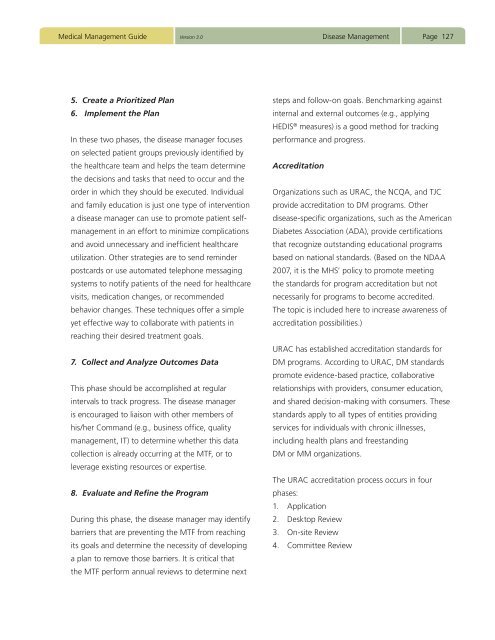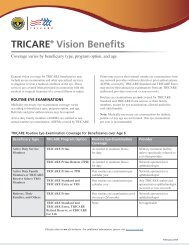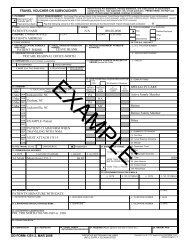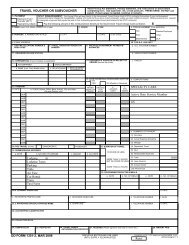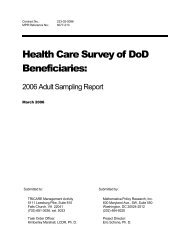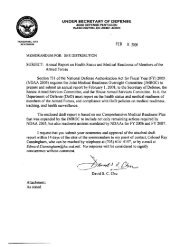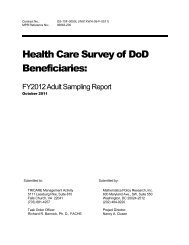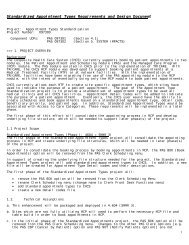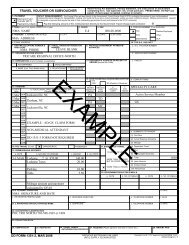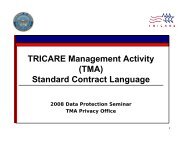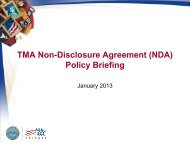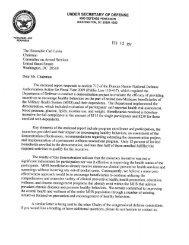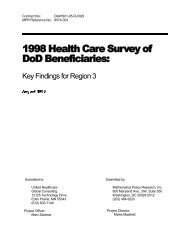Medical Management Guide, 2009, Version 3.0 - Tricare
Medical Management Guide, 2009, Version 3.0 - Tricare
Medical Management Guide, 2009, Version 3.0 - Tricare
- No tags were found...
Create successful ePaper yourself
Turn your PDF publications into a flip-book with our unique Google optimized e-Paper software.
<strong>Medical</strong> <strong>Management</strong> <strong>Guide</strong><strong>Version</strong> <strong>3.0</strong>Disease <strong>Management</strong>Page 1275. Create a Prioritized Plan6. Implement the PlanIn these two phases, the disease manager focuseson selected patient groups previously identified bythe healthcare team and helps the team determinethe decisions and tasks that need to occur and theorder in which they should be executed. Individualand family education is just one type of interventiona disease manager can use to promote patient selfmanagementin an effort to minimize complicationsand avoid unnecessary and inefficient healthcareutilization. Other strategies are to send reminderpostcards or use automated telephone messagingsystems to notify patients of the need for healthcarevisits, medication changes, or recommendedbehavior changes. These techniques offer a simpleyet effective way to collaborate with patients inreaching their desired treatment goals.7. Collect and Analyze Outcomes DataThis phase should be accomplished at regularintervals to track progress. The disease manageris encouraged to liaison with other members ofhis/her Command (e.g., business office, qualitymanagement, IT) to determine whether this datacollection is already occurring at the MTF, or toleverage existing resources or expertise.8. Evaluate and Refine the ProgramDuring this phase, the disease manager may identifybarriers that are preventing the MTF from reachingits goals and determine the necessity of developinga plan to remove those barriers. It is critical thatthe MTF perform annual reviews to determine nextsteps and follow-on goals. Benchmarking againstinternal and external outcomes (e.g., applyingHEDIS ® measures) is a good method for trackingperformance and progress.AccreditationOrganizations such as URAC, the NCQA, and TJCprovide accreditation to DM programs. Otherdisease-specific organizations, such as the AmericanDiabetes Association (ADA), provide certificationsthat recognize outstanding educational programsbased on national standards. (Based on the NDAA2007, it is the MHS’ policy to promote meetingthe standards for program accreditation but notnecessarily for programs to become accredited.The topic is included here to increase awareness ofaccreditation possibilities.)URAC has established accreditation standards forDM programs. According to URAC, DM standardspromote evidence-based practice, collaborativerelationships with providers, consumer education,and shared decision-making with consumers. Thesestandards apply to all types of entities providingservices for individuals with chronic illnesses,including health plans and freestandingDM or MM organizations.The URAC accreditation process occurs in fourphases:1. Application2. Desktop Review3. On-site Review4. Committee Review


